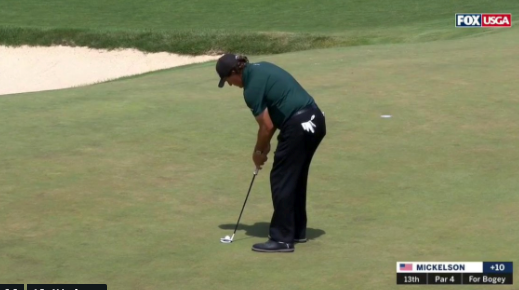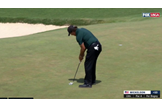Phil Mickelson offers his explanation on intentional rules infringement
Last updated:
In one of the most bizarre things to happen at the 2018 US Open, Phil Mickelson ran up to his moving ball and hit it back towards the hole. And it turns out he knew what he was doing…
Mickelson was already four-over for his round when he decided to intentionally hit his ball while it was still moving on the par-four 13th, which stopped the ball from rolling further away and possibly off the front of the green.
The incredibly bizarre act shocked golf commentators and fans alike, and meant he was deliberately accepting a two-shot penalty – leaving him with a 10 for that particular hole.
A senior rules official confirmed to Sky Sports that under rule 14-5 Phil was given a two-stroke penalty for making a stroke at a moving ball. He made four shots to get to the green and four putts, so with the penalty his score was assessed as a 10.
The USGA used the 14-5 rule instead of rule 1-2, as they deemed his actions to be covered with the ruling that he ‘made a stroke’ at his moving ball instead of acting ‘with the intent to influence the movement of a ball in play.’ A serious breach of rule 1-2 is a DQ, but because they deemed the ruling under 14-5, it was a two shot penalty instead of disqualification.
The USGA PR twitter account wrote: “During play of the 13th hole Phil Mickelson made a stroke on the putting green at the time his ball was moving. As a result, he incurred a two stroke penalty for a breach of Rule 14-5. His score for the hole was 10.”
Afterwards, Phil spoke to the media at Shinnecock Hills, and said that he meant no disrespect to the tournament but he was aware of the rule and used it to his advantage.
“I don’t mean disrespect by anybody, I know it’s a two shot penalty and at that time I didn’t feel like going back and forth and I took the two shot penalty and moved on. It’s my understanding of the rules, I’ve had multiple times where I’ve wanted to do that I just finally did it.
“No question it was going to go down in to the same spot behind the bunker and I don’t know if I would be able to save a shot but I know it’s a two shot penalty hitting a moving ball, I tried to hit it as close to the hole as I could to make the next one and you take the two shots and move on.
When asked if it showed disrespect to the championship, Phil responded;
“It’s certainly not meant that way. It’s meant to take advantage of the rules as best you can and in that situation I was just going back and forth and I’d gladly take the two shots over continuing that display”
Phil’s 11-over 81 matched his highest ever score in a US Open. In 27 appearances, he has shot an 81 twice – at Pebble Beach in 1992, and on his birthday on Saturday at Shinnecock Hills.
WATCH the video below to see what happened…
…And if you thought it was the first time something like this has happened in a US Open, you’d be mistaken. John Daly hit a moving ball in protest of unfair pins at the 1999 U.S. Open at Pinehurst, going on to make an 11. He was also assessed a two shot penalty on his way to a final-round 12-over 83.
But the real question: Should Phil Mickelson have been disqualified? Or should he have withdrawn?
The USGA sent out a press release on Sunday morning to clarify the rule in greater detail, but they failed to mention Rule 33-7, which deals with disqualification penalties and committee discretion.
That particular rule says that “If a committee considers that a player is guilty of a serious breach of etiquette, it may impose a penalty of disqualification under this Rule.”
There are plenty of players and analysts alike that believe the USGA should have enacted this rule and disqualified him for a serious breach of etiquette, but given they didn’t, others then called for him to withdraw.
It then transpired that after Phil heard the amount of people asking if he should be disqualified, he got in touch with USGA CEO Mike Davis to offer that very thing.
“When he heard that he called Mike Davis and said ‘If I’ve done something that crosses the line that much, then I need to withdraw immediately,’ ” Phil’s wife Amy told media as he declined to speak any further on Sunday, saying that Davis assured him he was within the rules.
“You know it’s not his finest moment,” said Amy, “but hopefully he’ll learn from it. Like anybody, good people make mistakes. We all have a moment in life sometimes and that was kind of a moment I think for him.”
And whether you think he should have or not, Phil decided to play on the final day at Shinnecock Hills, shooting a one-under 69. And although the rule is clearly up to interpretation, it is certain that Mickelson will leave New York with an unfortunate mark against his US Open legacy.
Read what the USGA said below.

